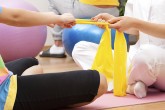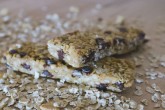
As the saying goes, you are what you eat. Well, not literally—otherwise, I’d be a Chipotle burrito bowl by now. But when it comes to combatting some of the ailments associated with running—or any form of vigorous exercise, for that matter—food plays a leading role. And nutritional science has come a long way since the days of putting the lime in the coconut to feel better. If you’re dealing with any of the following issues, here’s what to put on your grocery shopping list:
1. Muscle Soreness
If you exercise, chances are that you’ve experienced muscle soreness at one point or another. After all, to build strength, you first have to break down your muscle tissue—the fitness enthusiast’s equivalent of the old “you’ve got to spend money to make money” business axiom. But, as this article explains, “Eating the right foods before and after physical activity can help your muscles heal faster, ease soreness and pain and even protect against muscle damage in the first place.” Specifically, your diet should include a trifecta of protein, carbohydrates, and antioxidants.
Proteins
Protein-rich foods—like lean meat, poultry, fish, eggs, cheese, and beans—contain amino acids, which provide your body with the materials it needs to build and repair muscle cells.
Carbs
Carbohydrates—found in whole-wheat bread and pasta, brown rice, legumes, nuts, and raw vegetables—give you the energy boost necessary to recover fast.
Antioxidants
Antioxidants—like those contained in cherries, figs, eggplant, sweet potatoes, and blueberries—may “help protect skeletal muscles—such as those in your limbs—from wastes produced during strenuous physical activity.”
2. Stomach Cramps
If your workouts tend to hit you in the gut, try cutting out foods that commonly trigger digestive issues—like high-fat, high-fiber menu items—in the two to four hours leading up to your workout. Instead, stick to bland, easily digestible options like white rice, bananas, and applesauce. If you’re feeling adventurous, throw in some papaya or ginger; as this slide show notes, both items have been shown to soothe upset tummies. Finally, pay attention to your portion size. You don’t want to be starving when it comes time to get your sweat on, but you don’t want to feel full to the brim, either.
Also, remember that stomach pains—especially those pesky side stitches—sometimes stem from problems with your breathing, not your diet. As Olympic runner Jeff Galloway tells WebMD in this article, this type of pain often results from shallow breathing, acting as “a little alarm” to alert your body of the need to breathe deep.
3. Extreme Fatigue
Exercise makes you tired. I mean, that’s kind of the point, right? But if your energy levels are unusually low, or if you can’t seem to shrug off the sluggishness before and after you hit the gym—or the roads, trails, courts, or fields—your nutrition may be to blame. The first step to getting your groove back: nixing processed foods and simple starches and sugars. These options—though convenient—offer less energy-boosting nutritional value than their fresh-food counterparts. Furthermore, as this Healthline article explains, these foods are “typically full of preservatives, sodium, and other compounds that may slow you down.” In addition to upping your fresh fruit and vegetable intake, consider introducing nuts to your diet, if you haven’t already done so. According to the Healthline article, “Nuts are some of the best foods to beat fatigue and fight hunger. Nuts that provide energy include almonds, Brazil nuts, cashews, hazelnuts, pecans, and walnuts.”
One final note: long-distance runners—especially women—are prone to iron-deficiency (a.k.a. anemia), a condition that can cause energy levels to plummet. To keep iron levels up, be sure to consume enough iron-rich foods like leafy vegetables (spinach is great), red meat, seafood, beans, poultry, and dried fruit.
4. Muscle Cramps
Charlie horses (i.e., calf cramps) are the bane of many a runner’s existence. I will never forget the time both of my calves cramped up during a post-workout cool-down jog in college. On my long hobble back to campus, I had plenty of time to contemplate the error of my ways:
hot day + hard workout + direct sun + insufficient hydration and electrolytes = cramp city
If you’ve ever found yourself in a similar ordeal—or if you want to make sure you never do—be sure to add adequate hydration and electrolyte consumption to your pre-race or pre-workout ritual. How? “The day before a long workout, crunch on salty snacks such as pickles, soup, crackers or pretzels,” advises ACTIVE.com. Then, within an hour of your hard effort, “take an electrolyte drink…to replenish sodium lost through sweat.”
Maintaining a steady training regimen is never easy, but it’s even harder without the right fuel in the tank. Still have nagging aches and pains after cleaning up your pantry? Use our PT Finder tool to locate a physical therapist who can help you get back to feeling your best.


